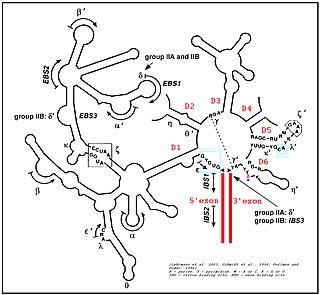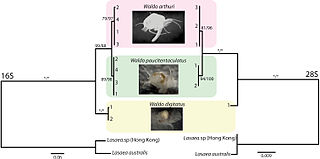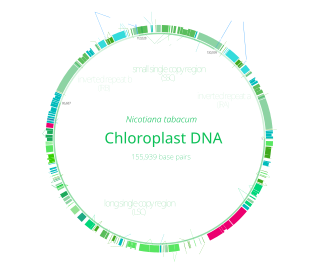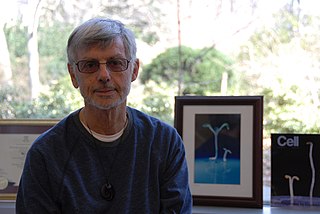Related Research Articles

Nucleic acids are large biomolecules that are crucial in all cells and viruses. They are composed of nucleotides, which are the monomer components: a 5-carbon sugar, a phosphate group and a nitrogenous base. The two main classes of nucleic acids are deoxyribonucleic acid (DNA) and ribonucleic acid (RNA). If the sugar is ribose, the polymer is RNA; if the sugar is deoxyribose, a variant of ribose, the polymer is DNA.

Symbiogenesis is the leading evolutionary theory of the origin of eukaryotic cells from prokaryotic organisms. The theory holds that mitochondria, plastids such as chloroplasts, and possibly other organelles of eukaryotic cells are descended from formerly free-living prokaryotes taken one inside the other in endosymbiosis. Mitochondria appear to be phylogenetically related to Rickettsiales bacteria, while chloroplasts are thought to be related to cyanobacteria.

In molecular biology, RNA polymerase, or more specifically DNA-directed/dependent RNA polymerase (DdRP), is an enzyme that catalyzes the chemical reactions that synthesize RNA from a DNA template.

Transfer RNA is an adaptor molecule composed of RNA, typically 76 to 90 nucleotides in length, that serves as the physical link between the mRNA and the amino acid sequence of proteins. Transfer RNA (tRNA) does this by carrying an amino acid to the protein-synthesizing machinery of a cell called the ribosome. Complementation of a 3-nucleotide codon in a messenger RNA (mRNA) by a 3-nucleotide anticodon of the tRNA results in protein synthesis based on the mRNA code. As such, tRNAs are a necessary component of translation, the biological synthesis of new proteins in accordance with the genetic code.
Polyadenylation is the addition of a poly(A) tail to an RNA transcript, typically a messenger RNA (mRNA). The poly(A) tail consists of multiple adenosine monophosphates; in other words, it is a stretch of RNA that has only adenine bases. In eukaryotes, polyadenylation is part of the process that produces mature mRNA for translation. In many bacteria, the poly(A) tail promotes degradation of the mRNA. It, therefore, forms part of the larger process of gene expression.

RNA editing is a molecular process through which some cells can make discrete changes to specific nucleotide sequences within an RNA molecule after it has been generated by RNA polymerase. It occurs in all living organisms and is one of the most evolutionarily conserved properties of RNAs. RNA editing may include the insertion, deletion, and base substitution of nucleotides within the RNA molecule. RNA editing is relatively rare, with common forms of RNA processing not usually considered as editing. It can affect the activity, localization as well as stability of RNAs, and has been linked with human diseases.

The start codon is the first codon of a messenger RNA (mRNA) transcript translated by a ribosome. The start codon always codes for methionine in eukaryotes and archaea and a N-formylmethionine (fMet) in bacteria, mitochondria and plastids.
In molecular biology, a twintron is an intron-within-intron excised by sequential splicing reactions. A twintron is presumably formed by the insertion of a mobile intron into an existing intron.

Group II introns are a large class of self-catalytic ribozymes and mobile genetic elements found within the genes of all three domains of life. Ribozyme activity can occur under high-salt conditions in vitro. However, assistance from proteins is required for in vivo splicing. In contrast to group I introns, intron excision occurs in the absence of GTP and involves the formation of a lariat, with an A-residue branchpoint strongly resembling that found in lariats formed during splicing of nuclear pre-mRNA. It is hypothesized that pre-mRNA splicing may have evolved from group II introns, due to the similar catalytic mechanism as well as the structural similarity of the Group II Domain V substructure to the U6/U2 extended snRNA. Finally, their ability to site-specifically insert into DNA sites has been exploited as a tool for biotechnology. For example, group II introns can be modified to make site-specific genome insertions and deliver cargo DNA such as reporter genes or lox sites

Polynucleotide Phosphorylase (PNPase) is a bifunctional enzyme with a phosphorolytic 3' to 5' exoribonuclease activity and a 3'-terminal oligonucleotide polymerase activity. That is, it dismantles the RNA chain starting at the 3' end and working toward the 5' end. It also synthesizes long, highly heteropolymeric tails in vivo. It accounts for all of the observed residual polyadenylation in strains of Escherichia coli missing the normal polyadenylation enzyme. Discovered by Marianne Grunberg-Manago working in Severo Ochoa's lab in 1955, the RNA-polymerization activity of PNPase was initially believed to be responsible for DNA-dependent synthesis of messenger RNA, a notion that was disproven by the late 1950s.

Sir David Charles Baulcombe is a British plant scientist and geneticist. As of 2017 he is a Royal Society Research Professor. From 2007 to 2020 he was Regius Professor of Botany in the Department of Plant Sciences at the University of Cambridge.

28S ribosomal RNA is the structural ribosomal RNA (rRNA) for the large subunit (LSU) of eukaryotic cytoplasmic ribosomes, and thus one of the basic components of all eukaryotic cells. It has a size of 25S in plants and 28S in mammals, hence the alias of 25S–28S rRNA.
Reginald John Ellis is a British scientist.

Chloroplast DNA (cpDNA) is the DNA located in chloroplasts, which are photosynthetic organelles located within the cells of some eukaryotic organisms. Chloroplasts, like other types of plastid, contain a genome separate from that in the cell nucleus. The existence of chloroplast DNA was identified biochemically in 1959, and confirmed by electron microscopy in 1962. The discoveries that the chloroplast contains ribosomes and performs protein synthesis revealed that the chloroplast is genetically semi-autonomous. The first complete chloroplast genome sequences were published in 1986, Nicotiana tabacum (tobacco) by Sugiura and colleagues and Marchantia polymorpha (liverwort) by Ozeki et al. Since then, a great number of chloroplast DNAs from various species have been sequenced.
George Gow Brownlee FRS FMedSci is a British pathologist and Fellow of Lincoln College, Oxford.
Sir Hugh Reginald Brentnall Pelham, is a cell biologist who has contributed to our understanding of the body's response to rises in temperature through the synthesis of heat shock proteins. He served as director of the Medical Research Council (MRC) Laboratory of Molecular Biology (LMB) between 2006 and 2018.

Ian Alexander Graham is a professor of Biochemical Genetics in the Centre for Novel Agricultural Products (CNAP) at the University of York.

Kenneth Henry Wolfe is an Irish geneticist and professor of genomic evolution at University College Dublin (UCD), Ireland.

Anthony R. Cashmore is a biochemist and plant molecular biologist, best known for identifying cryptochrome photoreceptor proteins. These specialized proteins are critical for plant development and play an essential role in circadian rhythms of plants and animals. A Professor emeritus in the Department of Biology at the University of Pennsylvania, Cashmore led the Plant Science Institute from the time of his appointment in 1986 until his retirement in 2011. He was elected to the National Academy of Sciences in 2003.
References
- 1 2 3 4 5 6 7 8 9 Anon (2017). "Leaver, Prof. Christopher John" . Who's Who (online Oxford University Press ed.). Oxford: A & C Black. doi:10.1093/ww/9780199540884.013.U24069.(Subscription or UK public library membership required.)
- 1 2 Leaver, Christopher John (1966). The correlation between nucleic acid synthesis and induced enzyme activity in plant tissue slices. london.ac.uk (PhD thesis). University of London (Queen Elizabeth College and Imperial College of Science and Technology). OCLC 681131873.
- 1 2 Anon (1982). "EMBO Member: Christopher J. Leaver". people.embo.org. European Molecular Biology Organization. Archived from the original on 5 August 2017.
- ↑ Graham, Ian Alexander (1989). Structure and function of the cucumber malate synthase gene and expression during plant development. ed.ac.uk (PhD thesis). University of Edinburgh. hdl:1842/12057. OCLC 557195389. EThOS uk.bl.ethos.278942.

- ↑ Graham, Ian A.; Smith, Laura M.; Brown, John W. S.; Leaver, Christopher J.; Smith, Steven M. (1989). "The malate synthase gene of cucumber". Plant Molecular Biology. 13 (6): 673–684. doi:10.1007/BF00016022. PMID 2491683. S2CID 23684986.
- ↑ Hill, Steven Arthur (1990). The regulation of mitochondrial function during early seedling development in cucumber (Cucumis sativus L.). ed.ac.uk (PhD thesis). University of Edinburgh. hdl:1842/14071. OCLC 606083438. EThOS uk.bl.ethos.652440.

- 1 2 Chris J. Leaver publications indexed by Google Scholar
- ↑ Chris J. Leaver publications indexed by the Scopus bibliographic database. (subscription required)
- ↑ Balk, J.; Leaver, C.; McCabe, P. (1999). "Translocation of cytochrome c from the mitochondria to the cytosol occurs during heat-induced programmed cell death in cucumber plants". FEBS Letters. 463 (1–2): 151–154. doi:10.1016/S0014-5793(99)01611-7. PMID 10601657. S2CID 6087038.
- ↑ Alpi, A.; Amrhein, N.; Bertl, A.; Blatt, M.; Blumwald, E.; Cervone, F.; Dainty, J.; De Michelis, M.; Epstein, E.; Galston, A. W.; Goldsmith, M. H. M.; Hawes, C.; Hell, R. D.; Hetherington, A.; Hofte, H.; Juergens, G.; Leaver, C. J.; Moroni, A.; Murphy, A.; Oparka, K.; Perata, P.; Quader, H.; Rausch, T.; Ritzenthaler, C.; Rivetta, A.; Robinson, D. G.; Sanders, D.; Scheres, B.; Schumacher, K.; Sentenac, H. (2007). "Plant neurobiology: no brain, no gain?". Trends in Plant Science. 12 (4): 135–136. doi:10.1016/j.tplants.2007.03.002. PMID 17368081.
- ↑ Swidzinski, J.; Sweetlove, L.; Leaver, C. (2002). "A custom microarray analysis of gene expression during programmed cell death in Arabidopsis thaliana". The Plant Journal. 30 (4): 431–446. doi: 10.1046/j.1365-313x.2002.01301.x . PMID 12028573.
- ↑ Fox, T. D.; Leaver, C. J. (1981). "The zea mays mitochondrial gene coding cytochrome oxidase subunit II has an intervening sequence and does not contain TGA codons". Cell. 26 (3): 315–323. doi:10.1016/0092-8674(81)90200-2. PMID 6276012. S2CID 41661616.
- ↑ May, M. J.; Vernoux, T.; Leaver, C.; Montagu, M. V.; Inze, D. (1998). "Glutathione homeostasis in plants: Implications for environmental sensing and plant development". Journal of Experimental Botany. 49 (321): 649–667. doi: 10.1093/jxb/49.321.649 .
- ↑ Leaver, C.; Key, J. (1967). "Polyribosome formation and RNA synthesis during aging of carrot-root tissue". Proceedings of the National Academy of Sciences of the United States of America. 57 (5): 1338–1344. Bibcode:1967PNAS...57.1338L. doi: 10.1073/pnas.57.5.1338 . PMC 224477 . PMID 5231738.
- ↑ Leaver, C.; Ingle, J. (1971). "The molecular integrity of chloroplast ribosomal ribonucleic acid". The Biochemical Journal. 123 (2): 235–243. doi:10.1042/bj1230235. PMC 1176928 . PMID 5001778.
- ↑ Trewavas, A; Leaver, CJ (2001). "Is opposition to GM crops science or politics? An investigation into the arguments that GM crops pose a particular threat to the environment". EMBO Reports. 2 (6): 455–9. doi:10.1093/embo-reports/kve123. PMC 1083916 . PMID 11415971.
- ↑ Anon (2009). "Imperial College Hornsund Expedition, 1962". Polar Record. 11 (74): 596. doi:10.1017/S0032247400055728. S2CID 251061959.
- 1 2 Anon (1986). "EC/1986/22: Leaver, Christopher John". Royal Society. Archived from the original on 4 January 2014.
- ↑ "Christopher Leaver MAE". ae-info.org. Academy of Europe.